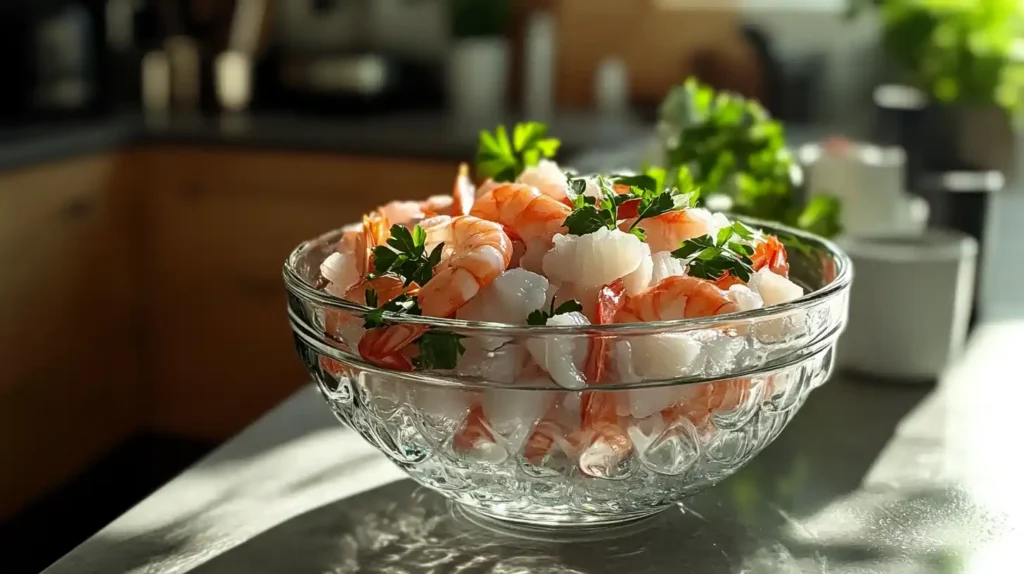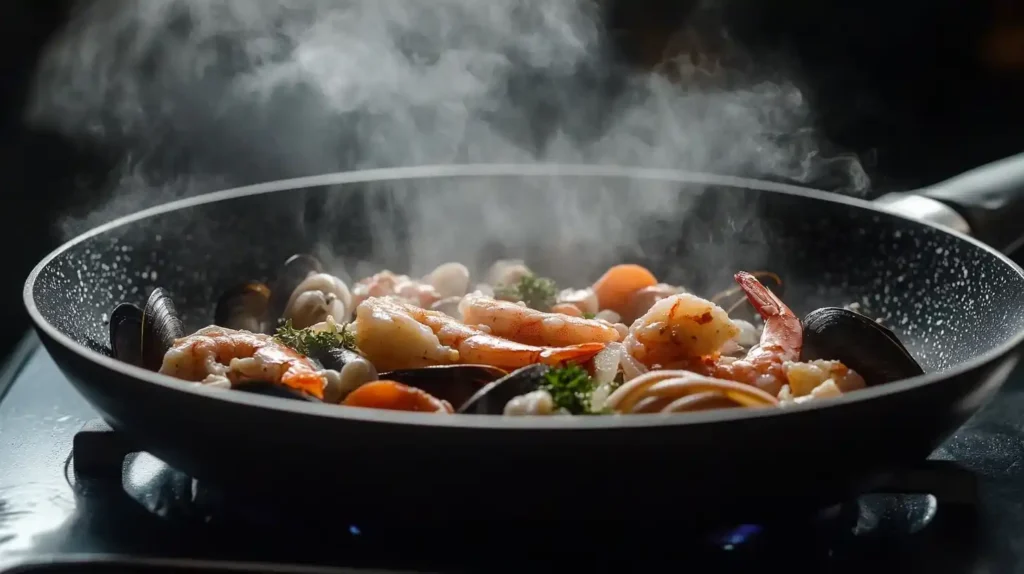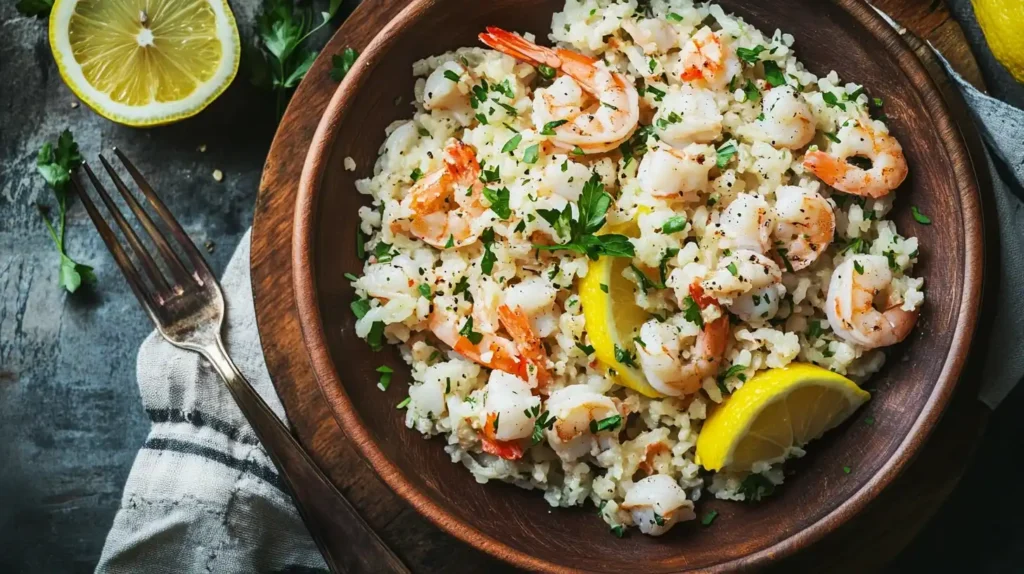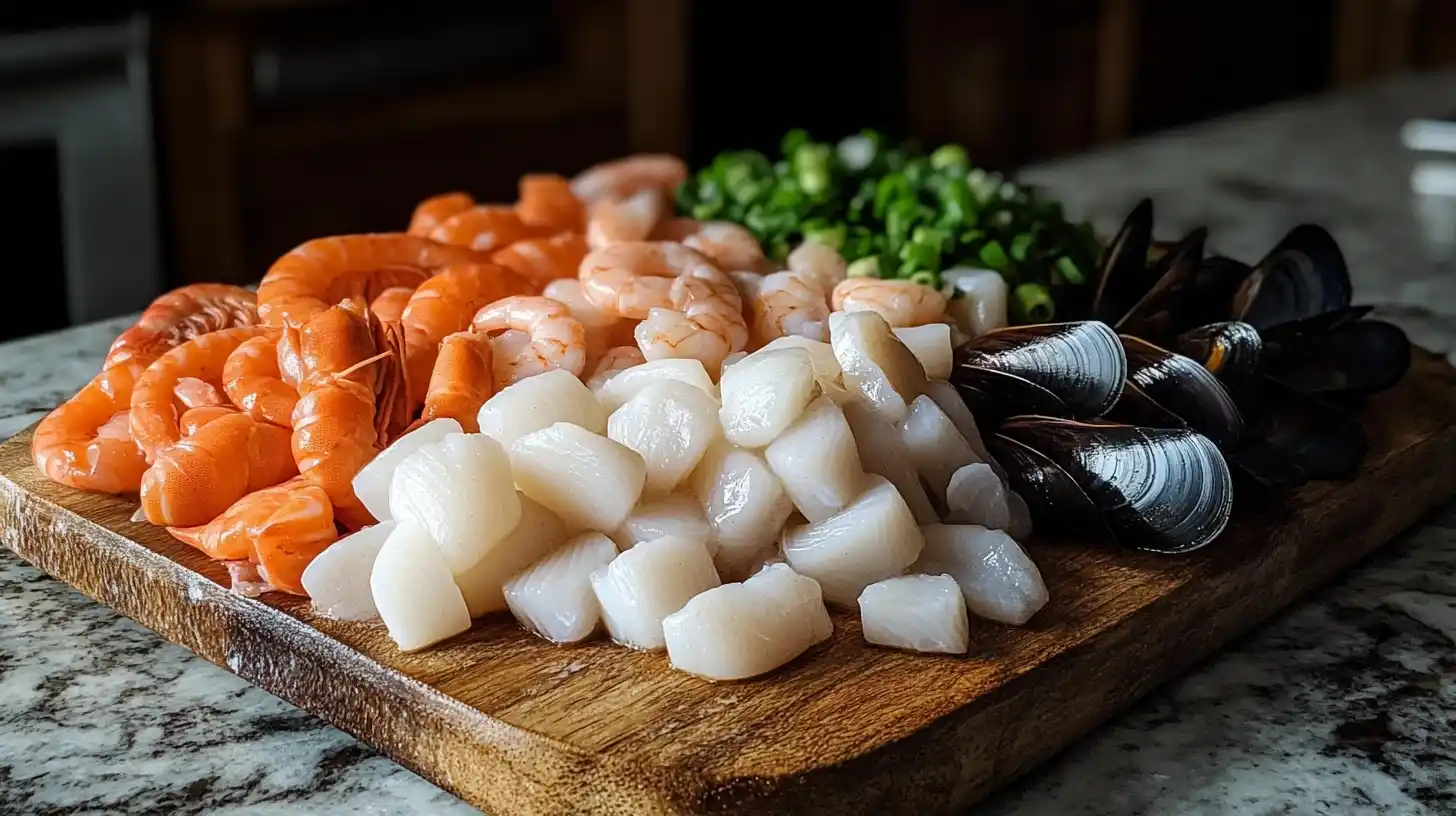Cooking frozen seafood mix may seem challenging, but with the right approach, you can achieve a delicious and well-balanced dish. Whether you are making a quick stir-fry, a creamy seafood pasta, or a flavorful grilled platter, understanding the best way to cook frozen seafood mix is essential.
One of the most common questions people ask is whether to thaw seafood before cooking or cook it directly from frozen. The answer largely depends on the cooking method.
Table of contents
- What is Frozen Seafood Mix?
- Should You Thaw Frozen Seafood Mix Before Cooking?
- Best Ways to Cook Frozen Seafood Mix
- Common Mistakes to Avoid When Cooking Frozen Seafood Mix
- Easy and Delicious Recipes for Frozen Seafood Mix
- How to Store Leftover Cooked Seafood Mix
- FAQs About Frozen Seafood Mix
- Final Thoughts
What is Frozen Seafood Mix?
A frozen seafood mix is a convenient blend of different types of seafood, typically including:
- Shrimp
- Squid
- Mussels
- Clams
- Scallops
- Imitation crab (sometimes included)
Should You Thaw Frozen Seafood Mix Before Cooking?
This is one of the most frequently asked questions. The answer, however, depends on the cooking technique you plan to use.
Thawing is recommended for:
- Stir-frying
- Grilling
- Baking
Cooking directly from frozen works well for:
- Boiling
- Steaming
- Adding to soups and stews
If you are unsure whether to thaw or not, consider the cooking time. Thawing allows seafood to cook evenly, preventing a rubbery texture.
Best Methods for Thawing Frozen Seafood Mix
Thawing frozen seafood mix properly helps preserve its natural texture and prevents it from becoming chewy. Here are the best methods:
- Refrigerator Thawing (Best Method)
- Place the frozen seafood mix in a bowl.
- Cover and refrigerate overnight.
- Cold Water Thawing (Faster Method)
- Place the sealed seafood package in a bowl of cold water.
- Change the water every 15 minutes until fully thawed.
Although the microwave may seem like a quick option, avoid using it as it can cook some parts unevenly while leaving others still frozen.

How to Perfectly Cook Frozen Seafood Mix at Home
Cooking frozen seafood mix at home is simple when you use the right techniques. Whether you want to sauté, boil, bake, or steam, the key is to lock in flavor while keeping the seafood tender. Follow these tips to cook it like a pro!
1. Choose the Right Cooking Method
The best way to cook frozen seafood mix depends on your dish. If you want a quick meal, sautéing works best. For soups and stews, boiling is ideal. If you prefer hands-free cooking, baking is a great option. And for a healthier choice, steaming preserves nutrients without extra oil.
2. Cook from Frozen or Thaw First?
You can cook seafood mix straight from the freezer, but thawing helps improve texture and even cooking. To thaw, place it in the fridge overnight or submerge it in cold water for 30 minutes. If you’re short on time, cook it frozen, but adjust the cooking time slightly.
3. Add Flavor for the Best Taste
Frozen seafood mix absorbs flavors quickly. Use garlic, butter, lemon juice, fresh herbs, or spices for extra taste. A splash of white wine or soy sauce can also enhance the flavor.
4. Avoid Overcooking
Seafood cooks fast! Overcooking makes it rubbery and dry. Most seafood mix is done in 5–7 minutes whether sautéed, boiled, baked, or steamed. Cook just until the seafood turns opaque and firm.
5. Pair with the Right Ingredients
For a complete meal, serve seafood mix with pasta, rice, or fresh veggies. You can also toss it into soups, salads, or tacos for variety.
By following these simple tips, you’ll cook frozen seafood mix perfectly every time. Try different cooking methods and enjoy delicious seafood dishes at home! 🍤🍽️
Best Ways to Cook Frozen Seafood Mix
Once thawed, or if cooking directly from frozen, the following cooking methods work best:
1. Sautéing or Stir-Frying
Best for: Quick meals with vegetables, pasta, or rice
Tip: Thaw seafood first for even cooking
- Heat olive oil or butter in a pan.
- Add garlic, onions, or ginger for extra flavor.
- Stir-fry seafood for 3–5 minutes until opaque.
- Season with salt, pepper, lemon juice, or soy sauce for enhanced taste.
Since seafood cooks quickly, it is important to avoid overcooking, as it may become rubbery.
2. Boiling or Poaching
Best for: Soups, stews, and pasta dishes
Tip: No need to thaw
- Bring water or broth to a boil.
- Add the frozen seafood mix directly.
- Cook for 5–7 minutes until the seafood turns opaque.
- Drain and use in soups or pasta dishes.
Because seafood absorbs flavors well, adding spices and herbs while boiling enhances the taste.
3. Baking
Best for: Seafood casseroles and roasted seafood platters
Tip: Thaw first
- Preheat the oven to 375°F (190°C).
- Arrange seafood mix on a baking tray.
- Drizzle with olive oil, garlic, and lemon juice.
- Bake for 12–15 minutes until the seafood is cooked through.
If you want a crispy texture, consider broiling for the last few minutes.
4. Grilling
Best for: BBQs and smoky flavors
Tip: Thaw first for best texture
- Preheat the grill to medium heat.
- Skewer seafood for easy flipping.
- Grill for 3–5 minutes per side.
- Brush with butter, garlic, or herbs for added flavor.
Since grilling can dry out seafood quickly, brushing with oil helps retain moisture.
5. Steaming
Best for: Healthy, low-fat cooking
Tip: No need to thaw
- Place frozen seafood mix in a steamer basket.
- Steam over boiling water for 5–8 minutes.
- Serve with soy sauce or butter sauce for a simple yet delicious dish.
Steaming is a great option for those looking for a nutritious, low-fat cooking method.

Common Mistakes to Avoid When Cooking Frozen Seafood Mix
Cooking frozen seafood mix is convenient, but if not done correctly, it can lead to rubbery, dry, or flavorless seafood. To ensure the best results, here are some common mistakes to avoid and tips to improve your seafood dishes.
1. Overcooking the Seafood
Why it’s a mistake:
Seafood cooks much faster than meat or poultry. Overcooking makes shrimp rubbery, squid tough, and scallops dry.
How to avoid it:
- Cook seafood just until opaque and firm.
- Use medium heat instead of high heat.
- Time your cooking: shrimp takes 3–4 minutes, squid 2–3 minutes, and mussels open in 5–7 minutes.
2. Not Thawing Properly
Why it’s a mistake:
If you thaw seafood incorrectly, it may become mushy or lose its natural texture.
How to avoid it:
- Thaw in the refrigerator overnight for the best results.
- For a faster method, place the sealed bag in cold water for 15–30 minutes.
- Avoid thawing in warm water or using the microwave, as this can partially cook some parts while leaving others still frozen.
3. Cooking from Frozen When It’s Not Recommended
Why it’s a mistake:
While some methods work well with frozen seafood, others require thawing for even cooking.
How to avoid it:
- Cook from frozen when boiling, poaching, or steaming.
- Thaw first when grilling, baking, or stir-frying to prevent excess water in the dish.
4. Not Removing Excess Water Before Cooking
Why it’s a mistake:
Frozen seafood releases a lot of water, which can make stir-fries soggy and baked seafood watery.
How to avoid it:
- After thawing, pat seafood dry with paper towels.
- When stir-frying, cook seafood separately first, then mix with other ingredients.
5. Using High Heat for Too Long
Why it’s a mistake:
Seafood cooks quickly, and high heat can cause it to become tough and overcooked.
How to avoid it:
- Use medium heat instead of high heat.
- If grilling, use indirect heat and brush with oil to prevent drying.
6. Not Seasoning Enough
Why it’s a mistake:
Seafood has a mild flavor, and if not seasoned properly, it can taste bland.
How to avoid it:
- Add bold flavors like garlic, lemon, paprika, chili flakes, and fresh herbs.
- Marinate for 15–30 minutes before cooking to enhance the taste.
7. Adding Seafood Too Early in Soups or Stews
Why it’s a mistake:
Seafood cooks much faster than other ingredients, so if added too early, it will overcook and lose texture.
How to avoid it:
- Cook vegetables, rice, or pasta first.
- Add seafood in the last 5–7 minutes of cooking.
8. Cooking Different Types of Seafood at the Same Time
Why it’s a mistake:
Shrimp, squid, and mussels have different cooking times. Cooking them together can result in some seafood being overcooked while others remain undercooked.
How to avoid it:
- Cook seafood in stages, starting with those that take longer to cook.
- Remove cooked seafood from heat and add it back just before serving.
9. Not Using Enough Fat or Oil
Why it’s a mistake:
Seafood is lean, so if cooked without enough butter, oil, or sauce, it can become dry and stick to the pan.
How to avoid it:
- Use butter, olive oil, or coconut oil for richness.
- Baste with butter while grilling or baking to lock in moisture.
10. Skipping the Resting Time
Why it’s a mistake:
Like meat, seafood benefits from resting for a minute or two before serving.
How to avoid it:
- After cooking, let seafood rest for 2–3 minutes before serving to allow juices to redistribute.
Easy and Delicious Recipes for Frozen Seafood Mix
1. Garlic Butter Seafood Mix Skillet
- Heat butter in a pan.
- Add garlic, chili flakes, and parsley for flavor.
- Add thawed seafood mix and sauté for 4–5 minutes.
- Squeeze lemon juice and serve over rice.
2. Spicy Seafood Soup
- Bring vegetable broth to a boil.
- Add frozen seafood mix, chili paste, and ginger.
- Simmer for 10 minutes.
- Garnish with fresh cilantro for extra flavor.
3. Creamy Seafood Pasta
- Cook pasta and set aside.
- In a pan, heat olive oil and garlic.
- Add thawed seafood mix and sauté until fully cooked.
- Stir in cream, Parmesan, and herbs.
- Toss with pasta and serve immediately.
These recipes are simple, yet packed with flavor, making them perfect for quick meals.
How to Store Leftover Cooked Seafood Mix
If you have leftovers, follow these storage tips:
- Refrigerate in an airtight container – Keeps for up to 2 days.
- Freeze for later use – Use within 3 months.
- Reheat gently – Use low heat to prevent overcooking.
Leaving cooked seafood at room temperature for too long increases the risk of spoilage, so store it properly.
FAQs About Frozen Seafood Mix
Can you cook frozen seafood mix without thawing?
Yes, but only for methods like boiling, steaming, or adding to soups.
How do you prevent frozen seafood mix from becoming chewy?
Avoid overcooking, and always use medium heat.
What seasonings go well with seafood mix?
Lemon juice, garlic, paprika, butter, and fresh herbs enhance the flavor.
Can I cook frozen seafood mix in an air fryer?
Yes, air-fry at 375°F for 7–10 minutes, shaking the basket halfway through.
How do you know if seafood is fully cooked?
Seafood should turn opaque and firm, with a slight spring when pressed.

Final Thoughts
Cooking frozen seafood mix is easy when you follow the right methods. Whether stir-frying, boiling, or grilling, choosing the correct technique ensures a flavorful and perfectly cooked dish.
For more inspiration, check out Delicious Spaghettini Pasta Recipes if you’re pairing seafood mix with pasta.
By following these guidelines, you can confidently prepare a delicious seafood meal at home. Try different seasonings, experiment with recipes, and enjoy the variety of seafood flavors in every bite.

